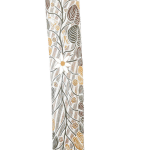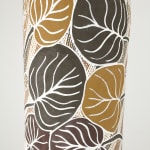Djul'djul Gurruwiwi Yolgnu, b. 16/12/1965
88 5/8 x 7 1/2 in
Further images
This imagery refers to perhaps the oldest continuous human religious iconographical practice: the story of the Rainbow
Serpent. Estimates vary from 40,000-60,000 years on the depictions of the Rainbow Serpent in West Arnhem rock shelters.
Amongst the Dhatam, waterlillies, two ancestral figures travelled Gälpu clan lands and on further, during the days of early times called Waŋarr: Wititj, the all powerful rainbow serpent (olive python) and Djaykuŋ the Javanese filesnake that is a companion and possibly alternate incarnation of Wititj, living in amongst the Dhatam, or waterlillies, causing ripples and rainbows (Djari) on the surface of the water (one reference in the cross hatch).
The story of Wititj is of storm and monsoon, in the ancestral past. It has particular reference to the mating of Wititj during the beginning of the wet season when the Djarrwa (square shaped thundercloud) begin forming and the lightning starts striking.
The Galpu clan miny’tji (sacred clan design behind the lillies) represents Djari (rainbows) and the power of the lightning
within them. It also refers to the power of the storm created by Wititj, the diagonal lines representing trees that have been knocked down as Wititj moves from place to place. The ribs of the snake also form the basis of the sacred design here.











